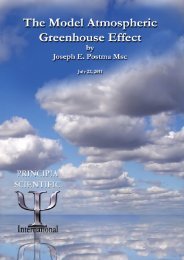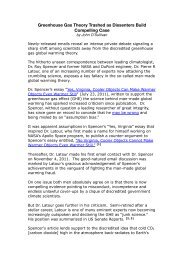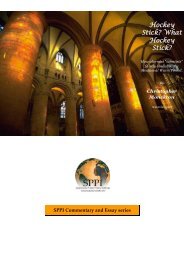Than 1000 International Scientists Dissent Over Man-Made Global ...
Than 1000 International Scientists Dissent Over Man-Made Global ...
Than 1000 International Scientists Dissent Over Man-Made Global ...
You also want an ePaper? Increase the reach of your titles
YUMPU automatically turns print PDFs into web optimized ePapers that Google loves.
Furthermore, Arctic permafrost zones revert to marshy peat bogs when the Arctic warms,<br />
and then bacterial activity takes hold and converts decaying ancient vegetation into<br />
atmospheric CO2. Both of those processes are happening right now," Smith wrote. "The<br />
Russian Vostok ice cores going back 420 000 years and the Dome-C ice cores going back<br />
730 000 years show that the Antarctic ice sheet has not melted during that time frame, even<br />
in the warmest interglacial periods. The ice cores also show periods of rapid global<br />
warming followed by rapidly increasing atmospheric CO2," he added. (LINK)<br />
Evolutionary Biologist and Paleozoologist Dr. Susan Crockford of University of<br />
Victoria in Canada has published papers in peer-reviewed academic journals and<br />
rejected fears that man-made global warming could devastate animal life on Earth. "It is<br />
apparent to me that animal species are much more flexible over the long term (centuries<br />
and millennia) than we assume based on short-term studies of local populations: most<br />
species have the capacity to adjust to abrupt climate or habitat change," Crockford told<br />
EPW on December 1, 2007. "While many individuals, or even entire local populations,<br />
may perish in the face of change, others do just fine (this variation in ‗survivability' among<br />
individuals within a population is characteristic of all species). The individuals who survive<br />
rebuild the population and the species perpetuates," Crockford added. "Contrary to popular<br />
belief, populations can rebound from quite low levels, as demonstrated by the fact that<br />
many population expansions (and introductions by humans) derive from a handful of<br />
individuals at best and often, a single pregnant female. Polar bears, for example, survived<br />
several episodes of much warmer climate over the last 10,000 years than exists today and if<br />
global numbers of bears dropped during these times, they must have rebounded nicely or<br />
there would not be so many bears today. Ringed seals, the primary prey of polar bears (and<br />
similarly dependant on sea ice), also survived these warm periods and are now very<br />
abundant," she added. "In other words, there is no evidence to suggest that the polar bear or<br />
its food supply is in danger of disappearing entirely with increased Arctic warming,<br />
regardless of the dire fairy-tale scenarios predicted by computer models: evidence from the<br />
past is a kind of ‗ground truth' we can trust and it tells us that sufficient sea ice will persist,<br />
even with significant increases in temperature, to ensure the survival of both polar bears<br />
and ringed seals," she concluded. (LINK)<br />
Meteorologist Herb Stevens, one of the original meteorologists at The Weather<br />
Channel and founder of Grass Roots Weather, expressed climate skepticism in 2007.<br />
"Based on my background as a scientist, you should also know that I am a firm believer<br />
that warming of out atmosphere is not caused by man. Quite simply, the evidence does not<br />
exist to prove a correlation between greenhouse gas emissions and rising atmospheric<br />
temperatures...the correlation does not pass muster with the scientific method, and until it<br />
does, thousands of other scientists and I continue to look elsewhere for the answers to<br />
questions of short and long term climate change," Stevens wrote on May 17, 2007. "The<br />
vast majority of the coverage of global warming suggests catastrophic consequences await<br />
in the not too distant future...mind you, all of those predictions for 25, 50, or even 100<br />
years in the future come from computer models, the same technology that quite often can't<br />
get tomorrow's weather right," Stevens explained. "It is especially troubling to scientists<br />
that the vast majority of spokespersons for global warming have little if any scientific<br />
background...politicians, actors, radio and television hosts, and other members of the<br />
media, most of whom have journalism backgrounds," Stevens added. "Unfortunately, due<br />
to the one-sidedness of the information barrage, much of our society has bought in to the<br />
255





